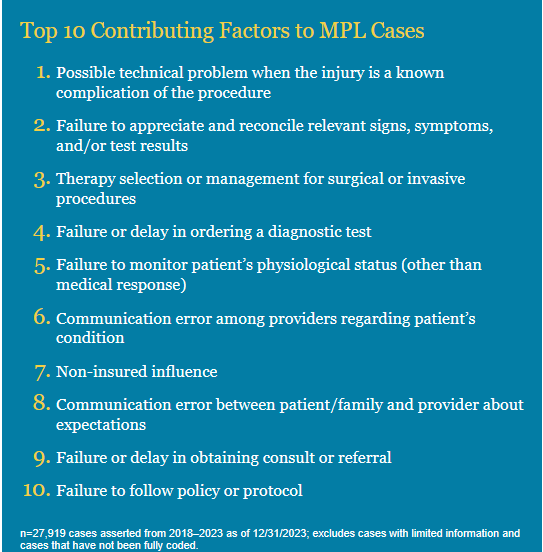Newsletter
Top Contributing Factors to Medical Malpractice Claims Deliver Clarity to Sources of Medical Error
Feb 05, 2024
Understanding what contributed to a medical professional liability (MPL) or malpractice claim is crucial to mitigating liability risk and helping health care providers deliver safe, high-quality patient care.
Candello, a division of CRICO, was established in 1998 with a mission to collect MPL data sourced from academic medical centers, community hospitals, captive and commercial insurers, and health care settings around the country to identify the many factors that can and do contribute to breakdowns in care. Candello’s proprietary taxonomy contains more than 250 contributing factors, aligning the systems, processes, and behaviors that connect care delivery with medical error. With the ability to link each member of the care team to specific actions (or inactions) in an associated case, along with case level and aggregated data, these codes are only a snippet of the robust taxonomy.
Using the deep data trove stored in Candello’s national database, containing one-third of all MPL claims asserted in the U.S., clinical and financial vulnerabilities and trends become clear. Looking at 27,919 MPL claims asserted between 2018–2023, Candello analytics identifies the top 10 contributing factors across this six-year period:
Diving into the Top Three Contributing Factors
We also found that the top three contributing factors listed above persisted, in the same order, in each year included in the analysis (2018–2023). Take a closer look at cases and disciplines where these factors often appear.
- Possible technical problem when the injury is a known complication of the procedure
- Present in 27 percent of the cases included in the analysis*
- Example: Obstetric malpractice claims often list technical issues as a contributing factor. Learn about the top risks in obstetrics care and how clinicians can better protect patients and themselves.
- Failure to appreciate and reconcile relevant signs, symptoms, or test results
- Present in 22 percent of the cases included in the analysis*
- Example: The failure to reconcile signs and symptoms was one of the factors that contributed to a 53-year-old man’s death.
- Therapy selection or management for surgical or invasive procedures
- Present in 16 percent of the cases included in the analysis*
- Example: Watch or listen to Dr. David Ring vulnerably share his experience of mistakenly performing the wrong surgery and reflect on how it happened.
Every malpractice case is unique, each with its own perfect storm of behavioral, system, and environmental factors. Looking at the overarching trends among tens of thousands of malpractice cases in Candello’s national database is a fundamental step toward addressing the weakest system vulnerabilities and providing the highest quality of care.
Other Resources and Findings from MPL Data
- Learning From Lawsuits: Using Malpractice Claims Data to Develop Care Transitions Planning Tools
- Lessons Learned from Medical Malpractice Claims Involving Critical Care Nurses
- 10 Simple Tips to Avoid Malpractice Claims
Recent Issues
Safety Nets for Safer Care


No Surgical Items Left Behind

Recently Asked Questions


